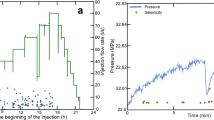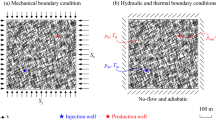Abstract
We provide a comparative analysis of the spatio-temporal dynamics of hydraulic fracturing-induced microseismicity resulting from gel and water treatments. We show that the growth of a hydraulic fracture and its corresponding microseismic event cloud can be described by a model which combines geometry- and diffusion-controlled processes. It allows estimation of important parameters of fracture and reservoir from microseismic data, and contributes to a better understanding of related physical processes. We further develop an approach based on this model and apply it to data from hydraulic fracturing experiments in the Cotton Valley tight gas reservoir. The treatments were performed with different parameters such as the type of treatment fluid, the injection flow rate, the total volume of fluid and of proppant. In case of a gel-based fracturing, the spatio-temporal evolution of induced microseismicity shows signatures of fracture volume growth, fracturing fluid loss, as well as diffusion of the injection pressure. In contrast, in a water-based fracturing the volume creation growth and the diffusion controlled growth are not clearly separated from each other in the space-time diagram of the induced event cloud. Still, using the approach presented here, the interpretation of induced seismicity for the gel and the water treatments resulted in similar estimates of geometrical characteristics of the fractures and hydraulic properties of the reservoir. The observed difference in the permeability of the particular hydraulic fractures is probably caused by the different volume of pumped proppant.








Similar content being viewed by others
References
Albright, J.N. and Pearson C.F. (1982), Acoustic emissions as a tool for hydraulic fracture location: Experience at the Fenton Hill Hot Dry Rock site, Soc. Petro. Eng. August, 523–530.
Arco Exploration and Production Technology (1997), Cotton Valley production stimulation hydrofracture Phase II, Technical Report, UPR Consortium.
Block, L.V., Cheng, C.H., Fehler, M.C., and Phillips, W.S. (1994), Seismic imaging using microearthquakes induced by hydraulic fracturing, Geophysics 59, 102–112.
Economides, M.J. and Nolte, K.G., (eds.) Reservoir Stimulation (Wiley, Chichester, 2003).
Fehler, M., House, L., and Kaieda, H. (1987), Determining planes along which earthquakes occur: Method and application to earthquakes accompanying hydraulic fractures. J. Geophys. Res. 92, 9407–9414.
Fischer, T., Hainzl, S., Eisner, L., Shapiro, S.A., and Le Calvez, J. (2008), Microseismic signatures of hydraulic fracture growth in sediment formations: Observations and modeling. J. Geophys. Res. 113, doi:10.1029/2007JB005070.
Harrington, L. and Hannah, R.R. Fracturing design using perfect support fluids for selected fracture proppant concentrations in vertical fractures. In SPE Annual Meeting (Dallas, September 1975).
Hubbert, M.K. and Willis, D.G. (1957), Mechanics of hydraulic fracturing. J. Pet. Tech. 9(6), 153–168.
Keck, R.G., and Withers, R.J. A field demonstration of hydraulic fracturing for solid waste injection with real-time passive seismic monitoring. In Proc 1994 Soc Petro. Eng. Annu. Tech. Conf., Paper 28495 (New Orleans, September 1994).
Nordgren, R.P. (1972), Propagation of a vertical hydraulic fracture, SPE J. 12(8), 306–314.
Parotidis, M., Shapiro, S.A., and Rothert, E. (2004), Back front of seismicity induced after termination of borehole fluid injection. Geophys. Res. Lett. 31, doi:10.1029/2003GL018987.
Pearson, C. (1981), The relationship between microseismicity and high pore pressures during hydraulic stimulation experiments in low permeability granitic rocks, J. Geophys. Res. 86, 7855–7864.
Perkins, T.K. and Kern, L.R. (1961), Width of hydraulic fractures, J Petro. Tech. 13(9), 937–949.
Phillips, W.S., House, L.S., and Fehler, M.C. (1997), Detailed joint structure in a geothermal reservoir from studies of induced microearthquake clusters, J. Geophys. Res. 102, 11745–11763.
Pinnacle Technologies, Cotton Valley fracture imaging project Phase III—Final Report. Technical Report (JIP Consortium, 1999).
Rowe, C.A., Aster, R.C., Phillips, W.S., Jones, R.H., Borchers, B., and Fehler, M.C. (2002), Using automated, high-precision repicking to improve delineation of microseismic structures at the Soultz geothermal reservoir. Pure Appl. Geophys. 159, 563–596.
Rutledge, J.T. and Phillips, W.S. (2003), Hydraulic stimulation of natural fractures as revealed by induced microearthquakes, Carthage Cotton Valley gas field, east Texas, Geophysics 68, 441–452.
Rutledge, J.T., Phillips, W.S., and Mayerhofer, M.J. (2004), Faulting induced by forced fluid injection and fluid flow forced by faulting: An interpretation of hydraulic-fracture microseismicity, Carthage Cotton Valley gas field, Texas, Bull. Seismol. Soc. Am. 94, 1817–1830.
Shapiro, S.A. and Dinske, C. (2007), Violation of the Kaiser effect by hydraulic-fracturing-related microseismicity. J. Geophys. Eng. 4, doi:10.1088/1742-2132/4/4/003.
Shapiro, S.A., Dinske, C., and Rothert, E. (2006), Hydraulic-fracturing controlled dynamics of microseismic clouds, Geophys. Res. Lett. 33, doi:10.1029/2006GL026365.
Shapiro, S.A., Huenges, E., and Borm, G. (1997), Estimating the permeability from fluid-injection induced seismic emission at the KTB site, Geophys. J. Int. 131, F15–F18.
Shapiro, S.A., Rothert, E., Rath, V., and Rindschwentner, J. (2002), Characterization of fluid transport properties of reservoirs using induced microseismicity, Geophysics. 67, 212–220.
Sileny, J., Eisner, L., Hill, D.P., and Cornet, F.H. (2008), Non-doubel-couple mechanisms of microearthquakes induced by hydraulic fracturing. In 70th EAGE Conference and Exhibition, page PO21 (Rome, June 2008).
Urbancic, T.I. and Rutledge, J.T. (2000), Using microseismicity to map cotton valley hydraulic fractures. In SEG Expanded Abstracts 19, doi:10.1190/1.1815676.
Walker, R.N. Cotton Valley hydraulic fracture imaging project. In Proc 1997 Soc. Petro. Eng. Annu. Tech. Conf. 38577 (San Antonio, October 1997).
Warpinski, N.R., Engler, B.P., Young, C.J., Peterson, R., Branagan, P.T., and Fix, J.E. Microseismic mapping of hydraulic fractures using multi-level wireline receivers. In Proc 1995 Soc. Petro. Eng. Annu. Tech. Conf. 30507 (Dallas, October 1995).
Wescott, W.A. (1984), Diagenesis of a tight gas formation: Jurassic Cotton Valley sandstone, East Texas Basin, AAPG Bull. 68, 118–125, doi:10.1306/AD4618C2-16F7-11D7-8645000102C1865D.
Acknowledgments
The research presented in this paper is supported by the sponsors of the PHASE University research project. We express our thanks to Scott Phillips and to one anonymous reviewer for their valuable comments and suggestions.
Author information
Authors and Affiliations
Corresponding author
Rights and permissions
About this article
Cite this article
Dinske, C., Shapiro, S.A. & Rutledge, J.T. Interpretation of Microseismicity Resulting from Gel and Water Fracturing of Tight Gas Reservoirs. Pure Appl. Geophys. 167, 169–182 (2010). https://doi.org/10.1007/s00024-009-0003-6
Received:
Revised:
Accepted:
Published:
Issue Date:
DOI: https://doi.org/10.1007/s00024-009-0003-6




